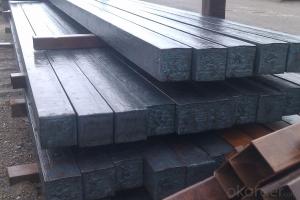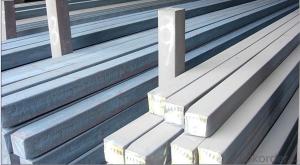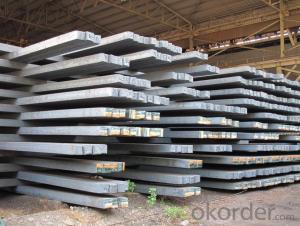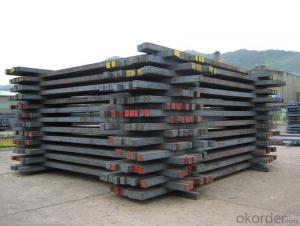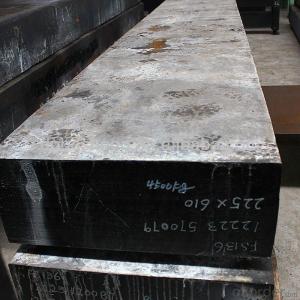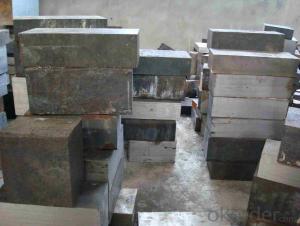Prime square alloy steel billet 135mm Q235
- Loading Port:
- Shanghai
- Payment Terms:
- TT OR LC
- Min Order Qty:
- 100 m.t.
- Supply Capability:
- 10000 m.t./month
OKorder Service Pledge
OKorder Financial Service
You Might Also Like
Structure of Prime square alloy steel billet 135mm Q235

Description of Prime square alloy steel billet 135mm Q235
Manufacture Progress:HRC-CRC-GALVANIZED-COLOR COATED
Application : Construction, electrical, transportation, steel plant, composite board plant, steel tile factory
Payment & Shipping Terms:T/T ,L/C, and FOB CHINA
Minimum Order Quantity: 25Tons
Packge Type: Moisture-proof paper inner,Steel outside,Bundle by steel rope.
Package in Container : Wood as a foot pad, wire rope reinforcement,PPGI steel coil tied together by steel rope.

Main Feature of Prime square alloy steel billet 135mm Q235
Uncoated CR steel sheet
With the features of in line with the international highest standards in demension and shape, excellent surface finish and properties, the products are mainly used in home appliance and automobile industries.
Galvanized steel sheet(include HDG and EG)
With the features of good corrosion resistance, the products are mainly used in automobile, home appliance, electronics, building and machinery manufacture industries, etc.
Precoated steel sheet
With the features of enviromental protection and good processablility, long lasting surface durability, rich in colors, the products are maily used in building, home appliance and furniture industries, etc.
Applications of Prime square alloy steel billet 135mm Q235
1) Excellent corrosion resistance: The zinc layer provides a good protection of Pre-painted Galvanizeed Steel Sheet.
2) High heat resistance: The reflective surface of the material aids in efficiently reflecting the sunlight away and in turn reducing the amount of heat transmitted. The thermal reflectivity converts into energy savings.
3) Aesthetics: Pre-Painted Galvanized steel sheet is available in plethora of patterns and multiple sizes as per the requirements that given by our customers.
4) Versatility: can be used in the various areas.

Specifications of Prime square alloy steel billet 135mm Q235
Product | Billet |
Material Grade | SGCC / SGCH / DX51D+AZ, etc |
Thickness | 0.6-3.0mm |
Width | 500-1500mm |
Tolerance | Thickness: +/-0.02mm , Width:+/-2mm |
Zinc-coating | Z30-150g/m2 |
Technique | Raw material: Hot rolled steel coil --> Cold rolled_>hot dipped galvalume |
Surface | Dried, Chromated, Unoiled |
Spangle | Regular spangle , small spangle, zero spangle |
ID | 508MM 610MM |
Coil weight | 1-25MT |
Export package | Cardboard inner sleeves, Waterproof paper, galvanized steel covered and steel strip packed |
FAQ of Prime square alloy steel billet 135mm Q235
We have organized several common questions for our clients,may help you sincerely:
1. How Can I Visit There?
Our company is located in Tianjin City, China, near Beijing. You can fly to Tianjin Airport Directly. All our clients, from home or aboard, are warmly welcome to visit us!
2. How Can I Get Some Sample?
We are honored to offer you sample.
3. Why choose CNBM?
we always fix steel produce in container well to make it safe arrive at destination port
we always provide best and professional forward service for our buyer
we always apply 14days free detention for our buyers container in destination
we provide one set After-sales service for our buyer
we provide China inland steel market price report
we help our buyer become number one in local market .
- Q:Can steel billets be coated for improved aesthetic appearance?
- Yes, steel billets can be coated to improve their aesthetic appearance. Coatings such as paints, powder coatings, and plating can be applied to steel billets to enhance their visual appeal. These coatings can provide a decorative finish, protect against corrosion, and improve the overall durability of the steel billets. Additionally, coatings can be customized to achieve specific aesthetic requirements, such as different colors, textures, or patterns, allowing for greater design flexibility. Therefore, coating steel billets is a common practice to achieve improved aesthetic appearance in various industries including construction, automotive, and consumer goods.
- Q:How are steel billets used in the production of aerospace structures?
- Steel billets are an essential component in the production of aerospace structures. These billets are typically made from high-quality steel and serve as the starting material for various aerospace components. They are used in forging, which is a manufacturing process that involves shaping the metal by applying compressive forces. Aerospace structures, such as aircraft frames, wing spars, landing gear components, and engine parts, require materials with exceptional strength, durability, and resistance to fatigue. Steel billets provide these qualities, making them ideal for the aerospace industry. The production of aerospace structures begins with the selection of the appropriate steel billets. These billets are carefully inspected to ensure they meet the required specifications and quality standards. Once approved, they undergo a series of processes, including heating, forging, and machining, to transform them into the desired shape and size. During the forging process, the steel billets are heated to a specific temperature and then subjected to intense pressure, either through hammering or pressing. This force causes the billets to deform and take the shape of the aerospace component being manufactured. The precise control of temperature and pressure ensures that the resulting structure has the desired mechanical properties and meets the stringent safety requirements of the aerospace industry. After forging, the aerospace structures are further machined and finished to achieve the necessary dimensional accuracy and surface quality. This may involve cutting, drilling, milling, and grinding processes. The steel billets' ability to withstand these machining operations without compromising their structural integrity is crucial in producing aerospace structures that meet the stringent performance standards. In summary, steel billets play a vital role in the production of aerospace structures by providing the necessary strength, durability, and fatigue resistance. Through forging and subsequent machining processes, these billets are transformed into various components, ensuring the structural integrity and safety of aerospace systems. The utilization of high-quality steel billets guarantees that the resulting structures meet the demanding requirements of the aerospace industry.
- Q:What are the different types of steel billet forming processes?
- The different types of steel billet forming processes include hot rolling, cold rolling, extrusion, forging, and casting.
- Q:What are the main factors affecting the tensile strength of steel billets?
- The main factors affecting the tensile strength of steel billets include the chemical composition of the steel, the heat treatment process, the presence of impurities or defects in the material, the grain size and orientation, and the processing conditions used during manufacturing.
- Q:What are the different types of welding processes used for joining steel billets?
- When it comes to joining steel billets, there are various welding processes available, each with its own unique characteristics and advantages depending on the project's specific requirements. Here, we present some of the commonly used welding processes for joining steel billets: 1. Shielded Metal Arc Welding (SMAW), also known as stick welding, utilizes a consumable electrode coated in flux that creates an arc between the electrode and the base material. This versatile process can be used for both thick and thin steel billets, making it widely employed in various industries. 2. Gas Metal Arc Welding (GMAW), commonly referred to as MIG welding, involves a continuous wire electrode and a shielding gas that protects the weld from atmospheric contamination. This process offers high productivity and is suitable for welding steel billets of different thicknesses. 3. Flux-Cored Arc Welding (FCAW), similar to GMAW, employs a continuously fed tubular electrode filled with flux. It is particularly suitable for welding thicker steel billets and finds applications in heavy fabrication. 4. Gas Tungsten Arc Welding (GTAW), also known as TIG welding, utilizes a non-consumable tungsten electrode and a separate filler metal. This process produces high-quality welds and is commonly used in applications that require precision and aesthetic appeal. 5. Submerged Arc Welding (SAW) involves a continuously fed electrode and a granular flux that covers the weld area. It is particularly suitable for welding thick steel billets and is often used in the construction of pressure vessels and heavy machinery. 6. Laser Beam Welding (LBW) employs a laser beam to generate heat and join the steel billets. This process offers high precision and speed, making it suitable for a wide range of applications, including automotive and aerospace industries. 7. Electron Beam Welding (EBW) uses a high-velocity electron beam to melt and join the steel billets. This process provides deep penetration and precise control, making it ideal for critical applications that require high-quality welds. When selecting the appropriate welding process, it is crucial to consider the specific requirements, thickness, and material properties of the steel billets. Consulting with a welding expert can help determine the most suitable method for a given project.
- Q:How are steel billets manipulated during the manufacturing process?
- Steel billets are manipulated during the manufacturing process through various methods such as heating, rolling, forging, and cutting. Heating the billets makes them more malleable and easier to shape. Rolling involves passing the heated billets through a series of rollers to reduce their thickness and create desired shapes. Forging is another technique where the billets are shaped using compressive forces. Finally, cutting is done to obtain specific lengths or shapes required for further processing or fabrication.
- Q:How are steel billets different from steel bars?
- Steel billets and steel bars are commonly used steel products in various industries, but they have some distinct differences. 1. Shape and Size: Steel billets are typically square or rectangular and have larger cross-sectional areas compared to steel bars. They are usually produced in sizes ranging from 100x100mm to 150x150mm or larger. In contrast, steel bars come in various shapes, such as round, square, flat, or hexagonal, and are available in smaller sizes based on their intended application. 2. Manufacturing Process: Steel billets are made through a primary steelmaking process known as continuous casting or ingot casting. This process involves solidifying molten steel into a semi-finished product, which is then further processed into steel bars or other forms. Conversely, steel bars are produced through a secondary steelmaking process called hot rolling or cold drawing. This process entails passing the steel billet through a series of rolling mills or drawing machines to achieve the desired shape and size. 3. Usage: Steel billets are primarily used as raw materials for manufacturing various steel products, including bars, rods, wire, pipes, and structural steel sections. They serve as a starting point for further processing and shaping. On the other hand, steel bars are the finished products used in construction, manufacturing, and other industries. They are commonly utilized in the production of reinforced concrete structures, automotive components, machinery parts, and tools. 4. Composition and Properties: Steel billets and bars are both made from carbon steel or alloy steel, but the specific composition and properties may vary depending on the desired end use. Steel billets are often made from low-carbon or mild steel, which provides good formability and weldability. In contrast, steel bars can be made from a wide range of steel grades, including low carbon, medium carbon, and high carbon steels, as well as alloy steels. The choice of steel grade depends on the desired mechanical properties, such as strength, hardness, and ductility. In summary, steel billets are semi-finished products used as raw materials for manufacturing steel bars and other steel products. They differ from steel bars in terms of shape, size, manufacturing process, usage, and composition.
- Q:What are the different types of casting processes used for shaping steel billets?
- Steel billets can be shaped using various casting processes. These methods include: 1. Continuous Casting: The most commonly used technique involves pouring molten steel into a continuously moving, water-cooled mold. The solidifying steel is continuously pulled out of the mold, resulting in a seamless billet. This process is efficient and allows for high production rates. 2. Centrifugal Casting: This method utilizes a rotating mold into which molten steel is poured. The centrifugal force evenly distributes the metal along the mold walls, creating a cylindrical billet. Centrifugal casting is known for producing high-quality, defect-free billets. 3. Ingot Casting: A traditional approach where molten steel is poured into a mold and left to solidify. The resulting solid steel, called an ingot, is then processed further to achieve the desired billet shape. Ingot casting offers flexibility in terms of billet size and shape. 4. Sand Casting: This process is suitable for manufacturing large and complex steel billets. It involves creating a mold using a mixture of sand and a binder. Molten steel is poured into the mold, and once it solidifies, the mold is removed to reveal the billet. While sand casting allows for custom-shaped billets, it is a slower and less precise method compared to others. 5. Investment Casting: Also known as lost-wax casting, this technique is ideal for intricate and complex billet shapes. Investment casting begins with the creation of a wax pattern in the desired shape. The wax pattern is then coated with a ceramic shell, and the wax is melted away, leaving behind a hollow mold. Molten steel is poured into the mold and solidifies, after which the ceramic shell is broken to retrieve the billet. Each casting process has its own advantages and disadvantages, and the choice depends on factors such as desired billet shape, size, production volume, and quality requirements.
- Q:How do steel billets contribute to the manufacturing of sports gear?
- Steel billets play a crucial role in the manufacturing of sports gear. These cylindrical or square-shaped semi-finished products are made by casting liquid steel into molds and then allowing them to solidify. Once the steel billets are formed, they can be further processed to create various sports equipment such as golf clubs, tennis rackets, baseball bats, and hockey sticks. One of the main reasons steel billets are used in the production of sports gear is due to their exceptional strength and durability. Steel is known for its high tensile strength, which means it can withstand significant amounts of force without breaking or deforming. This makes it an ideal material for sports equipment that requires resilience and longevity. Furthermore, steel billets offer excellent flexibility and customization options in terms of design and performance. Manufacturers can shape and mold the billets to create different types of sports gear, implementing specific features that enhance performance. For example, golf club heads are often made from steel billets, allowing manufacturers to manipulate the weight distribution to optimize the swing dynamics and increase distance. Steel billets also contribute to the performance of sports gear by providing stability and control. The rigid nature of steel ensures that the equipment maintains its shape and does not experience excessive vibrations during use. This stability is particularly crucial in sports like tennis or hockey, where precise control and accuracy are paramount. Moreover, steel billets can be combined with other materials to create composite sports gear. By integrating steel with materials like carbon fiber or titanium, manufacturers can create lightweight yet incredibly strong equipment. This combination allows for improved maneuverability and better overall performance. In summary, steel billets are vital components in the manufacturing of sports gear due to their exceptional strength, durability, flexibility, and customization options. From golf clubs to hockey sticks, steel billets contribute to the production of high-quality sports equipment that offers stability, control, and enhanced performance for athletes.
- Q:How does billet caster pull out billet cracking?
- There are many kinds of cracks. Which one are you talking about? It is related to the water radian of the crystallizer.
1. Manufacturer Overview |
|
|---|---|
| Location | |
| Year Established | |
| Annual Output Value | |
| Main Markets | |
| Company Certifications | |
2. Manufacturer Certificates |
|
|---|---|
| a) Certification Name | |
| Range | |
| Reference | |
| Validity Period | |
3. Manufacturer Capability |
|
|---|---|
| a)Trade Capacity | |
| Nearest Port | |
| Export Percentage | |
| No.of Employees in Trade Department | |
| Language Spoken: | |
| b)Factory Information | |
| Factory Size: | |
| No. of Production Lines | |
| Contract Manufacturing | |
| Product Price Range | |
Send your message to us
Prime square alloy steel billet 135mm Q235
- Loading Port:
- Shanghai
- Payment Terms:
- TT OR LC
- Min Order Qty:
- 100 m.t.
- Supply Capability:
- 10000 m.t./month
OKorder Service Pledge
OKorder Financial Service
Similar products
New products
Hot products
Related keywords
